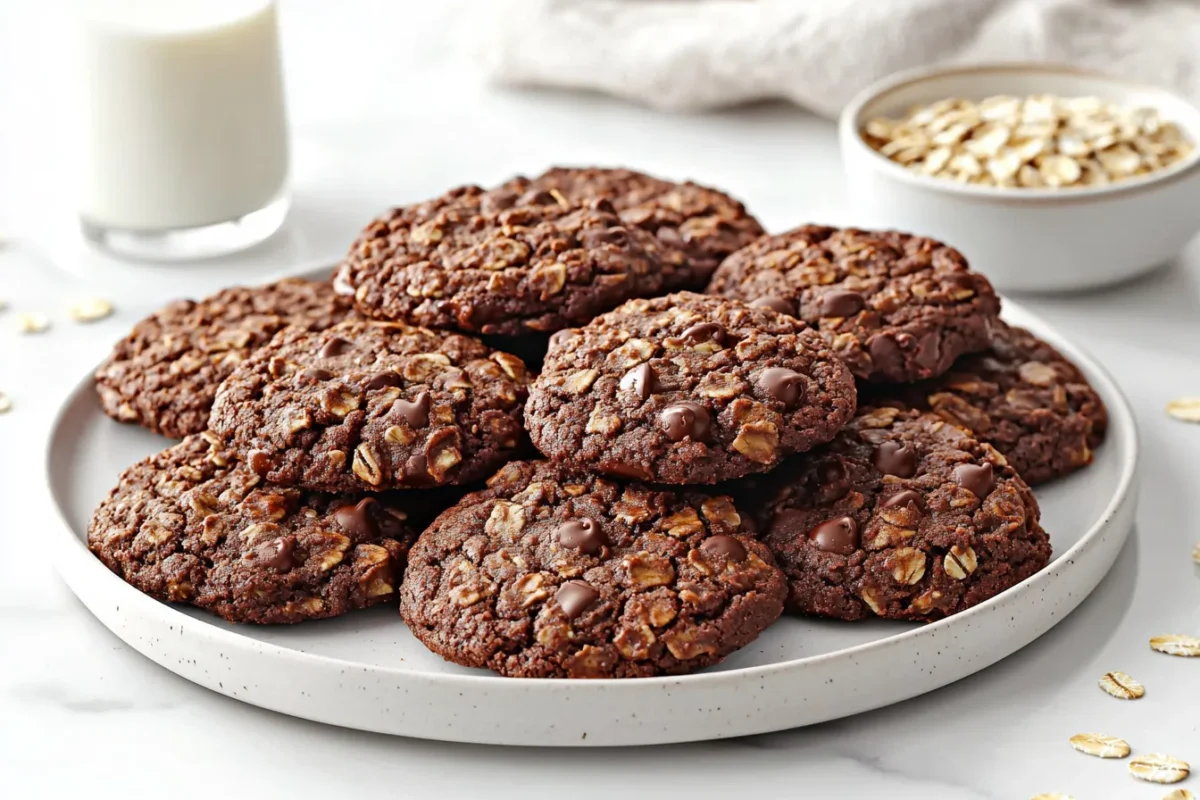Have you ever wondered, “Why are my chocolate oatmeal cookies gooey?” You’re not alone! Many bakers find themselves puzzled by this common cookie dilemma. Gooey cookies can be a blessing or a frustration, depending on your baking goals. But don’t worry—understanding the reasons behind the texture can be surprisingly simple and fun.
Gooey chocolate oatmeal cookies are soft, chewy, and oh-so-delicious. They’re a treat everyone loves, and with a little know-how, you can make them just the way you like. Whether you enjoy them gooey or want a firmer texture, there’s a perfect technique for you.
Ready to master your cookies? Keep reading to uncover easy tips, helpful tricks, and creative ideas for baking cookies that turn out perfectly every time.
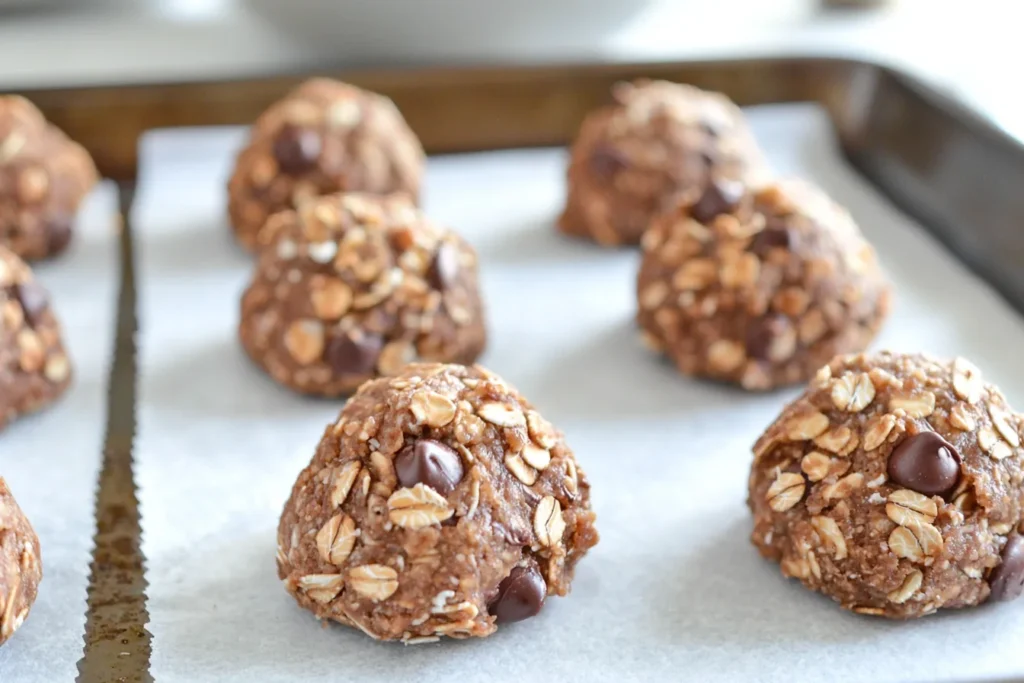
Discover other oatmeal-based delights like oatmeal raisin chocolate chip cookies for inspiration. What’s your favorite way to make gooey cookies? Share your thoughts in the comments below!
Table of Contents
Why Are My Chocolate Oatmeal Cookies Gooey? Common Causes
The Role of Baking Time and Temperature
Baking time and temperature play a huge role in determining cookie texture. If you bake your cookies at a low temperature, they might not set properly. This often results in a gooey, undercooked center. On the other hand, baking them at too high a temperature can lead to burnt edges and a raw interior.
Another factor to consider is baking time. Pulling the cookies out of the oven too soon will leave them gooey. While some people enjoy this texture, others prefer a firmer bite. First, ensure you preheat your oven properly. Next, follow the recipe’s recommended baking time, but check a minute earlier to avoid overbaking.
Learn more about adjusting baking time for perfect cookies with this oatmeal raisin chocolate chip recipe to achieve consistent results.
So, why are my chocolate oatmeal cookies gooey? Often, it’s a matter of getting the timing and temperature just right.
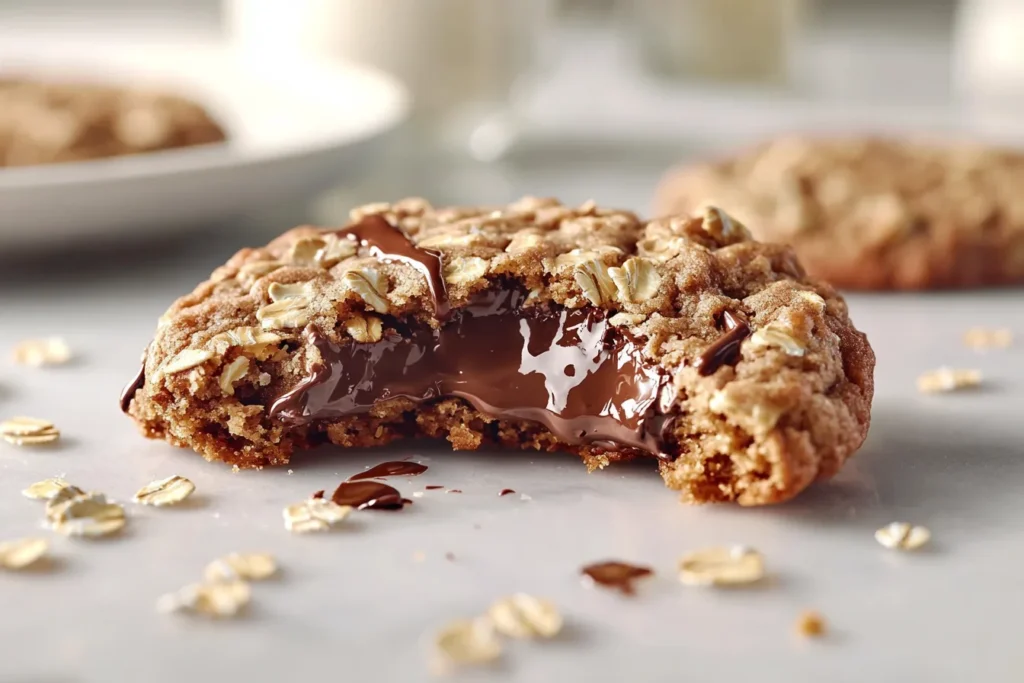
Adjust these elements, and your cookies will bake perfectly every time!
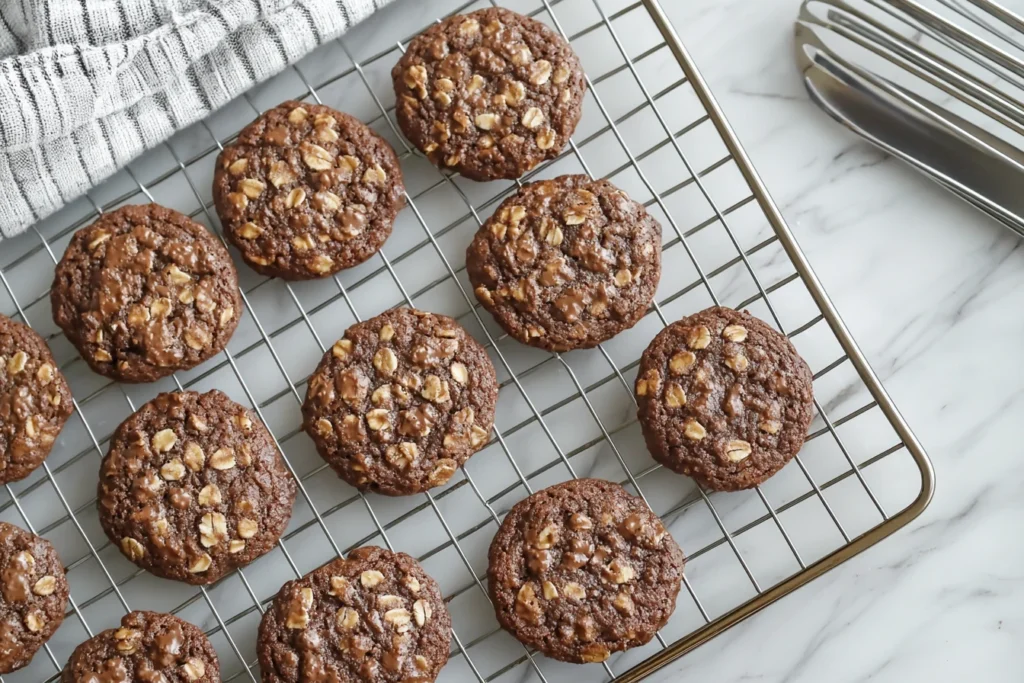
How Moisture in Ingredients Affects Texture
The moisture content in your ingredients significantly impacts your cookies’ gooey texture. Ingredients like butter, eggs, and sugar all contribute to how soft or firm your cookies turn out. For example, using too much butter can make cookies spread too much, leaving them gooey in the center and unevenly baked.
Similarly, eggs are another key factor. Adding an extra egg or using large eggs can increase moisture, creating a soft texture. Brown sugar also plays a role because it retains more moisture than white sugar, making the cookies chewy and gooey with a rich flavor.
Explore ingredient tweaks in this cornbread chocolate cake recipe for ideas on balancing moisture and flavor effectively in your cookies.
If you’re asking, “Why are my chocolate oatmeal cookies gooey?” consider tweaking these ingredients. Try reducing butter slightly or using a mix of white and brown sugar for balanced results. A small change can make all the difference in your next batch, giving you perfectly baked cookies.
Understanding the Science Behind Cookie Gooeyness
The Impact of Sugar Ratios on Texture
The type and amount of sugar in your recipe directly affect your cookies’ gooey texture. Brown sugar, for instance, contains more molasses, which adds moisture and chewiness. In contrast, white sugar creates a crisper texture due to its lower moisture content. Using a higher ratio of brown sugar to white sugar results in softer, gooier cookies with a deeper flavor.
Additionally, the sugar-to-flour balance is key. Too much sugar compared to flour can cause cookies to spread too thin, making them overly soft in the center. First, experiment with different sugar ratios. Then, adjust according to your texture preferences for the perfect cookie.
See how sugar balance impacts flavor in these chocolate oatmeal cookies for inspiration and tips. Learn the science behind perfect baking techniques from the USDA to refine your approach to sugar ratios and other key baking elements.
So, why are my chocolate oatmeal cookies gooey? Often, it’s because the sugar ratio leans toward moisture-heavy ingredients. By balancing these sugars carefully, you can create cookies with just the right level of gooeyness. Small tweaks lead to delicious improvements.
How Fats Like Butter Influence Gooey Cookies
Butter plays a crucial role in cookie texture. Melted butter creates a denser, gooier cookie because it adds liquid to the dough. Cold, solid butter, on the other hand, helps cookies maintain structure and prevents excessive spreading during baking.
Another factor is the amount of butter. Using too much butter can result in cookies that spread too much, leaving them thin and gooey in the middle. In addition, butter substitutes like coconut oil or margarine can affect texture differently, often leading to unexpected results. Using alternatives can change flavor and consistency significantly.
If you’re asking, “Why are my chocolate oatmeal cookies gooey?” take a closer look at your butter usage. Try using softened butter instead of melted, or reduce the quantity slightly for better structure. Small adjustments can make a big difference in achieving the perfect cookie texture for everyone’s enjoyment. Find inspiration for perfect butter ratios in this Southern cornbread recipe for better baking results.
How to Fix Gooey Chocolate Oatmeal Cookies and Achieve Perfect Texture
Adjusting Baking Time for Desired Consistency
Baking time is a key factor in getting the perfect cookie texture. Pulling cookies out of the oven too early will leave them undercooked and overly gooey in the center. On the other hand, leaving them in for too long can make them hard and dry, ruining their texture.
First, set a timer for a minute or two less than the recipe suggests. Then, check for doneness by gently pressing the center of a cookie. It should be soft but not wet. Next, let the cookies rest on the baking sheet for a few minutes after removing them from the oven.
So, why are my chocolate oatmeal cookies gooey? Sometimes, it’s a matter of slightly adjusting your baking time. Finding the right balance ensures cookies that are perfectly soft, chewy, and utterly delicious every single time.
Balancing Wet and Dry Ingredients for Even Results
The balance between wet and dry ingredients determines how your cookies bake. Too many wet ingredients, like eggs or butter, can result in cookies that spread too much and stay gooey in the middle. Conversely, too much flour can make cookies dense and dry, affecting their flavor and texture.
First, measure your ingredients carefully to maintain the right balance. Use a kitchen scale if possible for accuracy. Then, adjust as needed based on your dough’s consistency. If the dough feels overly sticky, add a small amount of flour. If it’s too dry, add a teaspoon of liquid at a time.
So, why are my chocolate oatmeal cookies gooey? It might be due to an imbalance in your wet and dry ingredients. Fine-tuning this balance ensures cookies that bake evenly and have the perfect chewy texture you’ll love.
Common Mistakes Leading to Gooey Oatmeal Cookies
Overmixing the Dough and Its Effects
Overmixing your cookie dough can lead to undesirable results, including an overly gooey texture. When you mix the dough too much, it develops more gluten. This can make the cookies dense and chewy in a way that feels underbaked. Overmixing also incorporates excess air, causing the cookies to spread unevenly during baking and lose structure quickly.
To avoid this, mix your dough just until the ingredients are combined. First, combine the wet and dry ingredients separately. Then, gently fold them together until you no longer see streaks of flour. Resist the urge to keep stirring, even if it looks fun or satisfying. Stop early to get the best results!
So, why are my chocolate oatmeal cookies gooey? Overmixing might be the culprit. Keeping your mixing minimal helps preserve the cookies’ texture, ensuring they turn out soft, chewy, and perfectly baked every time without frustration or wasted effort.
The Consequences of Improper Measuring Techniques
Improperly measuring your ingredients can drastically affect the outcome of your cookies. Adding too much butter or too little flour can lead to cookies that spread too much and stay gooey. Similarly, mismeasuring sugar can alter the texture, making cookies overly soft or sticky, and hard to shape or bake evenly.
Always use proper measuring tools, like dry cups for flour and liquid cups for milk or butter. Level off the flour with a flat edge to avoid packing it down too much. First, measure carefully and precisely. Then, double-check your recipe to ensure you’ve used the right quantities every single time. These small details matter a lot.
So, why are my chocolate oatmeal cookies gooey? It might be as simple as adjusting your measuring habits. Precise measurements ensure cookies bake evenly, giving you consistent results every single time and preventing baking disappointments or unnecessary confusion.
Making Chocolate Oatmeal Cookies Gooey on Purpose: Creative Tweaks
Using Brown Sugar and Chocolate for Extra Softness
If you love gooey cookies, brown sugar and chocolate are your best friends. Brown sugar contains molasses, which adds moisture and creates a chewy, gooey texture. It also enhances the flavor with a hint of caramel-like sweetness, making your cookies irresistibly soft.
The type of chocolate you use also plays a role. Dark chocolate melts more slowly, creating pools of gooey goodness in every bite. First, try using a mix of brown and white sugar for balanced texture. Then, add large chocolate chunks instead of chips for a gooier, meltier experience.
So, why are my chocolate oatmeal cookies gooey? Using brown sugar and the right chocolate could be the reason! These small adjustments help you intentionally create gooey cookies everyone will love. Don’t forget to share your delicious creations with friends and family!
Incorporating Ingredients Like Honey for a Chewy Texture
Adding honey to your cookie dough is a simple way to enhance gooeyness. Honey is a natural sweetener that retains moisture, resulting in cookies that stay soft and chewy even after cooling. It’s a fantastic alternative to refined sugar and adds a subtle floral flavor to your baked goods.
Another option is to mix in other sticky ingredients, like maple syrup or molasses, to boost the softness. These natural sweeteners not only improve the texture but also add depth to the flavor. First, replace a portion of the sugar with honey or syrup. Then, experiment with small quantities until you achieve your ideal cookie texture.
So, why are my chocolate oatmeal cookies gooey? Using ingredients like honey intentionally creates that chewy, gooey texture you crave. Try it today, and enjoy cookies that are deliciously soft with every bite!
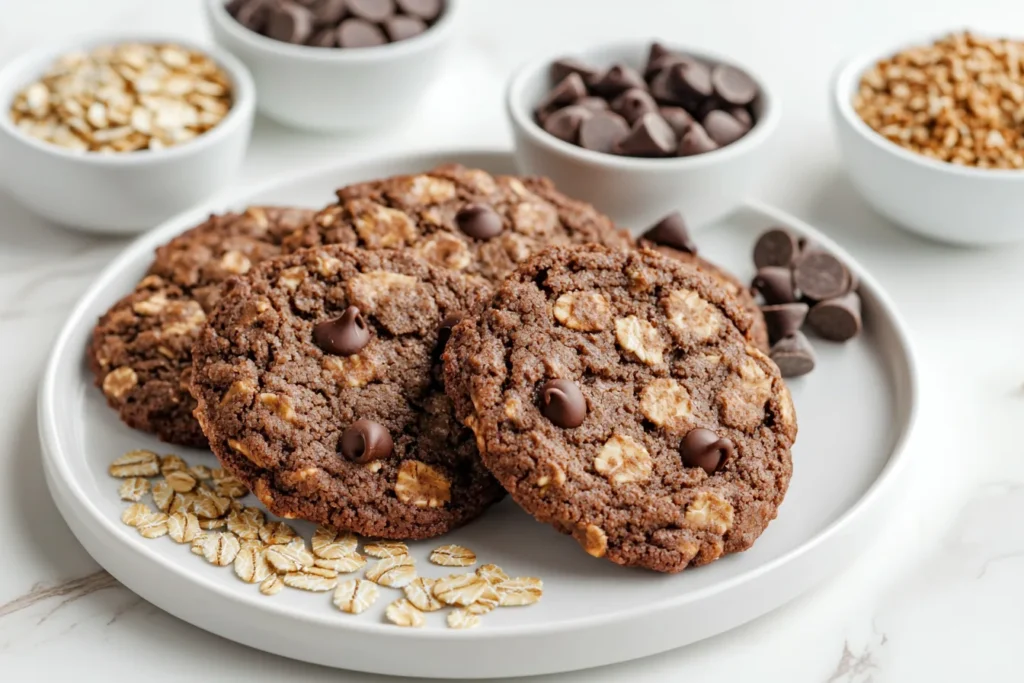
When Gooey Cookies Go Wrong: How to Fix Them
Simple Ways to Salvage Undercooked Cookies
Sometimes, cookies come out of the oven too gooey or undercooked in the center. The good news? You don’t have to throw them away! One simple fix is to return the cookies to the oven for a few more minutes. First, preheat the oven to a lower temperature, around 300°F. Then, bake the cookies again until the edges look set but not burnt, and the centers appear slightly firm.
Another option is to let the cookies cool completely. Often, cooling helps the centers firm up and become less gooey over time. If they’re still too soft, you can enjoy them as a dessert topping or crumble them over ice cream. So, why are my chocolate oatmeal cookies gooey? Undercooking might be the reason. These easy fixes can save your batch and turn them into delicious treats you’ll still love and want to share.
Troubleshooting Texture Issues for Future Batches
If gooey cookies are a recurring problem, adjusting your technique can help. First, check your oven temperature with an oven thermometer. Sometimes, ovens run hotter or cooler than expected, affecting bake times and leading to inconsistent results. Also, ensure you’re using the correct baking time and letting cookies rest on the baking sheet before transferring them, which helps them set.
Another tip is to adjust the dough’s moisture content. Reduce butter slightly or chill the dough before baking to prevent spreading. Then, use parchment paper to ensure even baking and minimize sticking. Finally, double-check your ingredient measurements to maintain the perfect balance.
So, why are my chocolate oatmeal cookies gooey? It could be small issues with your baking process or ingredient ratios. By troubleshooting these details, you’ll avoid problems and bake perfectly textured cookies every single time. Don’t forget to share your success stories with friends and family!
Frequently Asked Questions (FAQs)
Why are my oatmeal cookies gummy?
Gummy oatmeal cookies often happen when the dough is overmixed or contains too much moisture. Overmixing develops gluten, creating a dense texture that feels gummy. Using too much butter or eggs can also make the cookies overly soft and sticky.
First, measure your ingredients carefully to maintain the correct balance. Then, mix the dough just until the ingredients combine. If the dough feels too wet, add a little more flour to adjust the consistency.
If you’re wondering, “Why are my oatmeal cookies gummy?” these simple tweaks can make a big difference. Enjoy perfectly chewy cookies next time!
Why won’t my chocolate oatmeal cookies harden?
Chocolate oatmeal cookies that stay soft or won’t harden are often underbaked or contain too much moisture. Removing cookies from the oven too early can leave them soft. Using too much butter or not enough flour can also prevent them from setting properly.
First, ensure your oven temperature is accurate by using an oven thermometer. Then, bake the cookies until the edges are firm and slightly golden. Let them cool completely on the baking sheet, as this helps them firm up further.
If you’re asking, “Why won’t my chocolate oatmeal cookies harden?” these small adjustments can help. Try them for cookies with perfect texture!
Why are my cookies still gooey after baking?
Cookies that stay gooey after baking are often undercooked or removed from the oven too early. Baking at an incorrect temperature can also cause the centers to remain soft while the edges bake. Too much butter or sugar may increase moisture, resulting in gooey cookies.
First, check your oven temperature with an oven thermometer to ensure accuracy. Then, bake the cookies until the edges are firm and the centers are slightly set. Let them cool on the baking sheet to firm up.
If you’re wondering, “Why are my cookies still gooey after baking?” these tips can help. Try them for perfect cookies!
Why are my oatmeal cookies sticky?
Sticky oatmeal cookies are often caused by too much moisture in the dough. Using ingredients like honey, molasses, or too much brown sugar can make the cookies sticky. Additionally, underbaking can leave the cookies overly soft and sticky to the touch.
First, check your recipe and ensure your ingredient ratios are correct. Then, bake the cookies until the edges are firm and golden. Cooling them on a wire rack instead of the baking sheet can also help reduce stickiness.
If you’re asking, “Why are my oatmeal cookies sticky?” small adjustments like these can make a big difference. Enjoy perfectly textured cookies every time!
Master the Art of Baking Perfect Chocolate Oatmeal Cookies
Baking the perfect chocolate oatmeal cookies is easier than you think. Understanding why your cookies turn out gooey can help you take control of the process. Whether it’s adjusting the baking time, balancing ingredients, or tweaking sugar ratios, every small change can lead to big improvements.
Next, consider experimenting with creative tweaks like using brown sugar or adding honey for a softer texture. These simple tips can transform your cookies into the perfect treat. Also, remember that some gooeyness is part of the charm. With practice, you can decide how gooey or firm you want them.
So, why are my chocolate oatmeal cookies gooey? Now you know the reasons and the solutions! It’s time to grab your mixing bowl and start baking. Try these tips today, and share your delicious creations with family and friends. You’re going to love the results!

